As a concept, environmental enrichment is something that many veterinary surgeons, veterinary nurses and pet owners may be familiar with. The worried pet owner who brings some of their dog's bedding or favourite soft toys into hospital with them to reduce a pet's perceived anxiety is one basic example.
Whereas dogs and cats are traditionally given more opportunities to engage in natural behaviour when out for a walk or having outside access in general, many other species such as rabbits may be housed in fairly barren, restrictive environments and lack opportunities to engage in natural activities. This can impact significantly on their quality of life. ‘Generally accepted paradigms support the notion that expanding an animal's options for species-specific behavioural expression can positively affect both physiological and psychological wellbeing’ (Hutchinson et al, 2005: 151).
In order to provide the best environment for any species it is first necessary to have knowledge of that animal's behaviour (Hutchinson et al, 2005). What environment do they live in? What is important to them? For example, a rabbit may prioritise foraging for food and avoiding predators. Comparison of a wild rabbit to a captive rabbit can help to illustrate the importance of environmental enrichment.
Foraging
A rabbit's natural diet consists of very tough, fibrous foods of low nutritional value — they have a very diverse diet consisting of hay, grass, bark, and roots of many types of plants. Such low nutrient food means rabbits are accustomed to spending a large proportion of their time foraging and eating to obtain adequate nutrition (Mykytowycz et al, 1958). They have evolved constantly growing teeth to combat the wear caused by long periods of chewing and a specifically adapted digestive system to process high fibre foods. Just filling up a bowl of easily digested pellets or low fibre muesli mix is, therefore, inadequate enrichment for a rabbit!
Predator avoidance
While spending long periods of time out foraging rabbits must also avoid predators. This is achieved by having ready access to an escape route, or ‘bolt hole’ into their underground warrens and by being vigilant. Foraging together in a group means many pairs of eyes can be on the lookout for danger. Keeping a pet rabbit alone with no other rabbits to help stand guard for predators is unnatural. Similarly, letting rabbits roam out in a backyard with no hiding places to run to after a perceived threat can be very stressful. Many house rabbits lack access to the environmental constituents which allow expression of normal behaviour such as dirt for digging. Rabbits kept in isolation or confined to small hutches are unable to participate in a variety of normal behaviour and such conditions have an effect on both physical health and welfare (Buijs et al, 2011a).
From observation of wild rabbits, it is easy to imagine what would constitute basic environmental enrichment for pet rabbits — remembering that thousands of years of evolution (and being indoors) are not going to take away a pet rabbit's basic survival instincts:
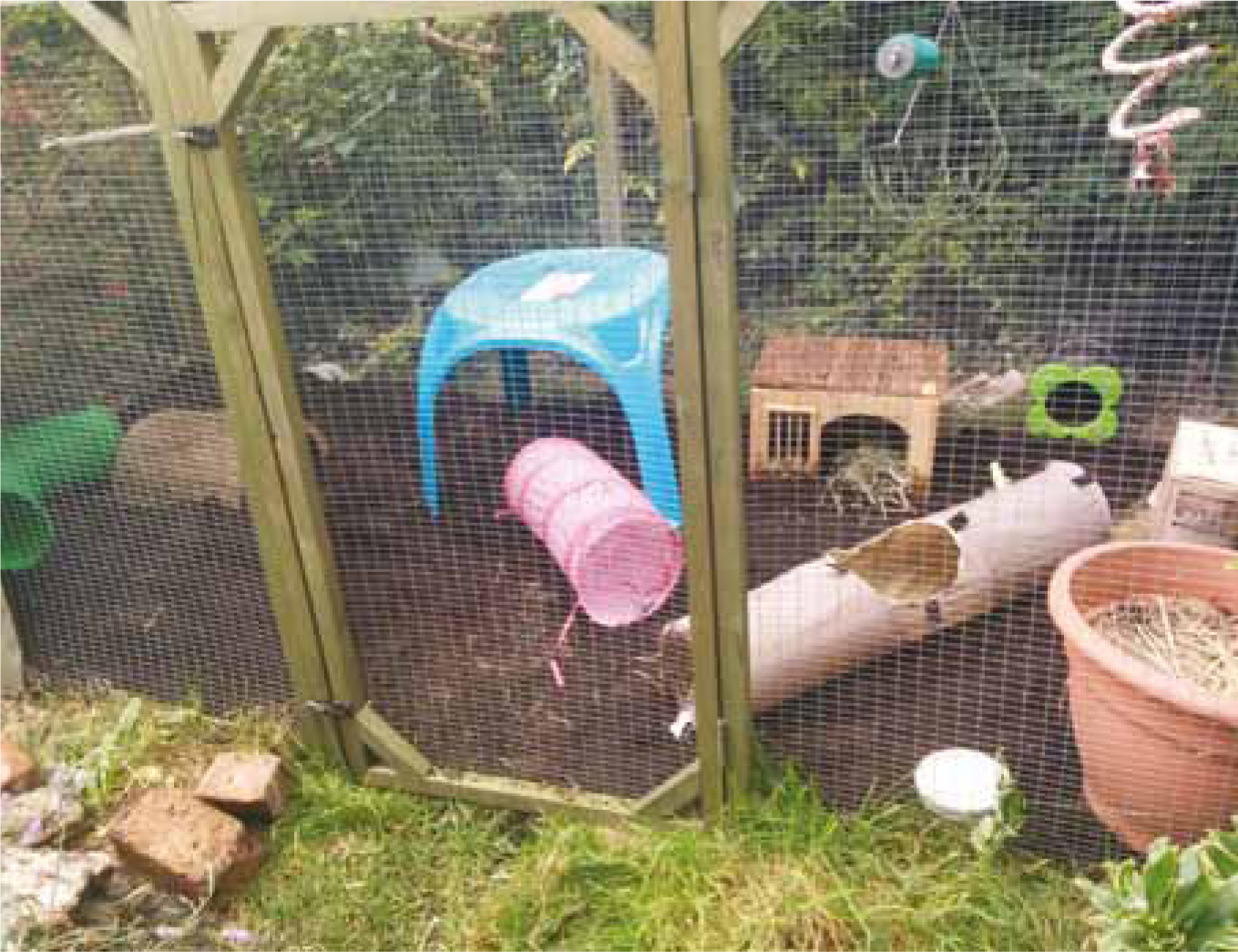
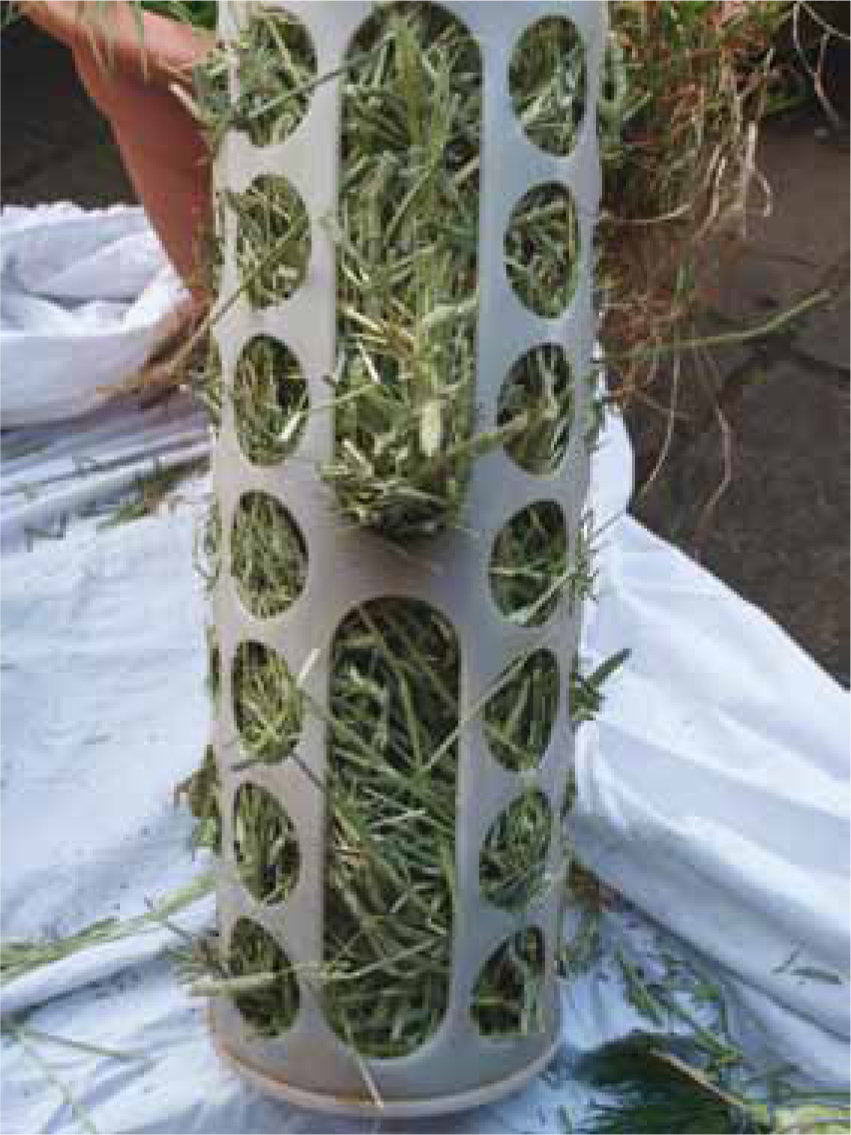
This is not dissimilar to the basic needs of an animal which must be legally met by any owner (The Animal Welfare Act, 2006):
Not only are there legal implications to neglecting to provide such care, many behaviours such as chewing and digging are still preformed even if the owner does not provide suitable environments for such behaviour. These activities are then seen as ‘destructive’ rather than ‘natural’ behaviours, for example when chewing is directed at the skirting boards rather than tree branches and digging is conducted on the new rug. This may impact the future of the rabbit–owner relationship.
With an estimated 1.3 million rabbits being kept as pets in the UK (PDSA Animal Wellbeing Report, 2014) this potentially leads to thousands of rabbits entering rehoming centres every year, although accurate figures on rabbit rehoming are currently lacking. In the rabbit behavioural book ‘Why Does my Rabbit…?’ (Mcbride, 1998) the author discusses in detail how many of the problems encountered with pet rabbits result from owners not providing opportunities for rabbits to express normal behaviours such as chewing and digging.
In addition to the legal and welfare grounds to encourage owners to engage in enrichment with their rabbits, there is also the prospect of owners developing a better understanding of the natural behaviours and the individual personalities of the rabbits that share their lives. This in turn makes looking after them more enjoyable.
How do you provide environmental enrichment for pet rabbits? Environmental enrichment comes in many forms and is usually a combination of housing-based enrichment, resource enrichment (food and toys) and companionship.
Housing
The most important piece of advice to give owners in relation to rabbit housing is to provide a large space. Unfortunately companion rabbits can legally be housed in hutches of smaller dimensions than those legally required by laboratory or farmed rabbits (Dixon et al, 2010). Dixon et al (2010) showed that rabbits in smaller enclosures are less active and engage in lower levels of normal activities than those in larger enclosures which impacts on their welfare.
All rabbits should have access to a spacious hutch with an attached run and be given the opportunity to exercise for several hours each day. Indoor rabbits should have long periods of supervised activity indoors and access to outdoors where possible.
As prey species they should have multiple hides placed in their environment to act as ‘bolt holes’. These can range from cardboard boxes and pieces of piping to specially manufactured rabbit tunnels of various sizes, shapes and colours. These can be rotated occasionally to maintain interest. Digging can be redirected away from floors and carpets to a digging box with a soil mixture for indoor rabbits.
Resources: food and toys
Dietary enrichment can be divided into two categories: improved variety, and foraging opportunities.
As discussed, rabbits need a high fibre food which involves extended chewing periods to wear down their teeth. The bulk of their diet should be good quality hay. A study conducted by Lidfors (1996) indicated that rabbits given hay showed a higher level of interaction with that enrichment than those given sticks, grass cubes or cardboard boxes, and a much lower percentage of stress-related behaviours such as bar chewing than those given boxes, sticks, grass cubes or nothing. Something as simple as the provision of hay in the environment of captive rabbits has been shown to significantly reduce stress-related behaviours such as bar biting and over grooming (Berthelsen and Hansen, 1999). Unfortunately a small survey conducted on the attitudes of UK rabbit owners showed that only 40% of them intended to provide hay and grass to their rabbit (Edgar and Mullan, 2011). Not only does this have a significant impact on their behavioural enrichment but has a huge impact on their dental health. Many owners who initially feed hay to their rabbits will give up if the rabbit becomes fussy or prefers to eat the pelleted food and vegetables. This may be because they are offering too much of these other foods in the diet or the hay is of poor quality.
Recommend that owners try presenting hay in different ways — they can make use of plant pots and hanging baskets (Figure 3), tie small bundles of hay with string and hang them up around their environment and place it in different spots to encourage foraging. Remember many rabbits are very fussy so if a rabbit goes off hay it may be necessary to make sure the quality is good and consider getting several different types of hay.
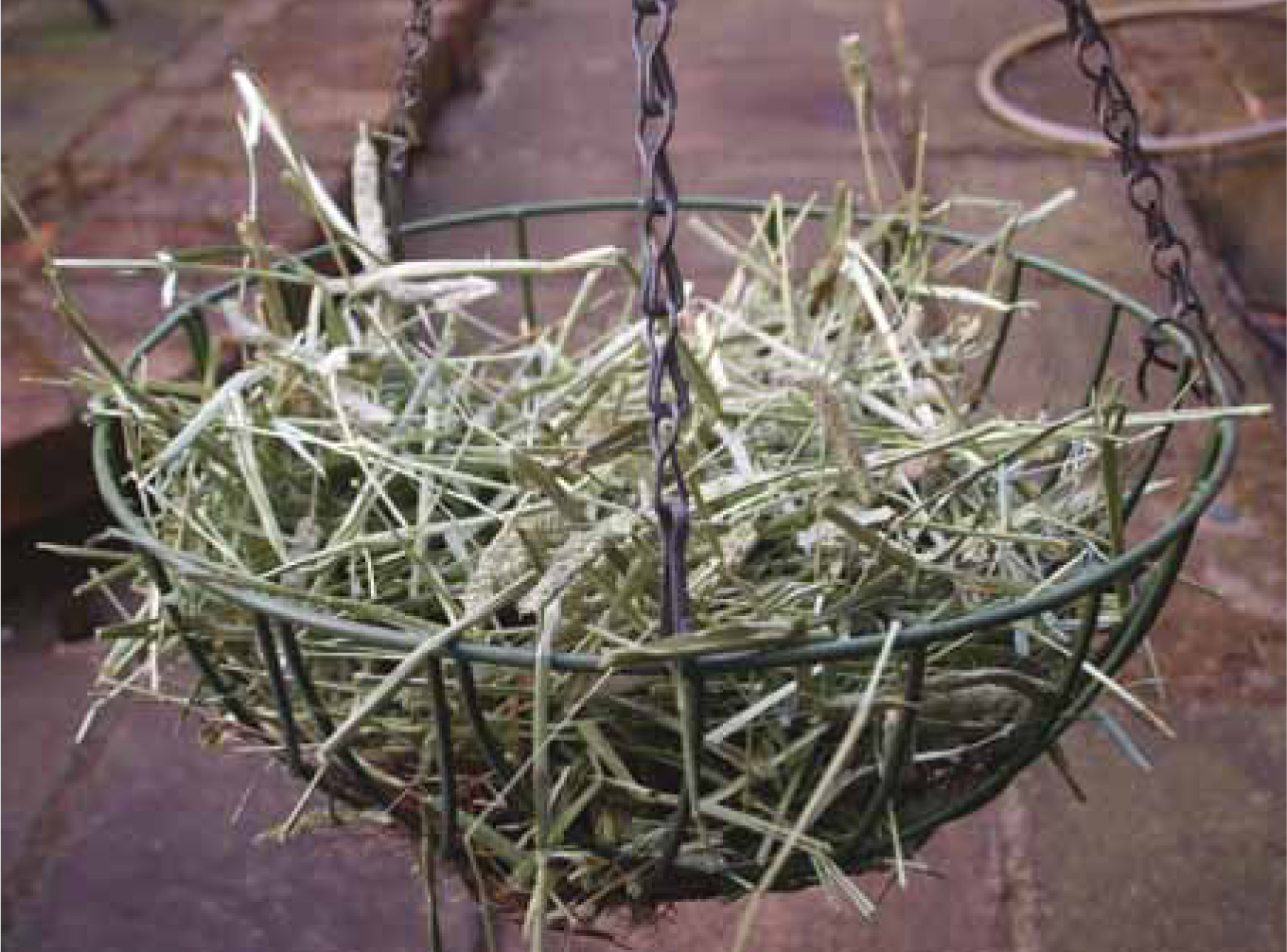
It is perfectly fine to give small quantities of other foods as well. Small amounts of herbs such as dill, sage and basil are really enjoyed by pet rabbits. A study by Harris et al (2001) showed that when compared with toys, food was a preferred enrichment option. Changing the types of dark green leafy vegetables offered so they are not being fed the same things every day (Figure 4) is important for nutritional and enrichment reasons. Owners can consider growing pots of clover, grass or dandelions which can be rotated in and out of their run or eaten by indoor rabbits (Figure 4 and 5). Various dried plants including bark, leaves, flowers and roots can be purchased online to help emulate a more natural environment (http://galensgarden.co.uk/shop/) (Figure 6).
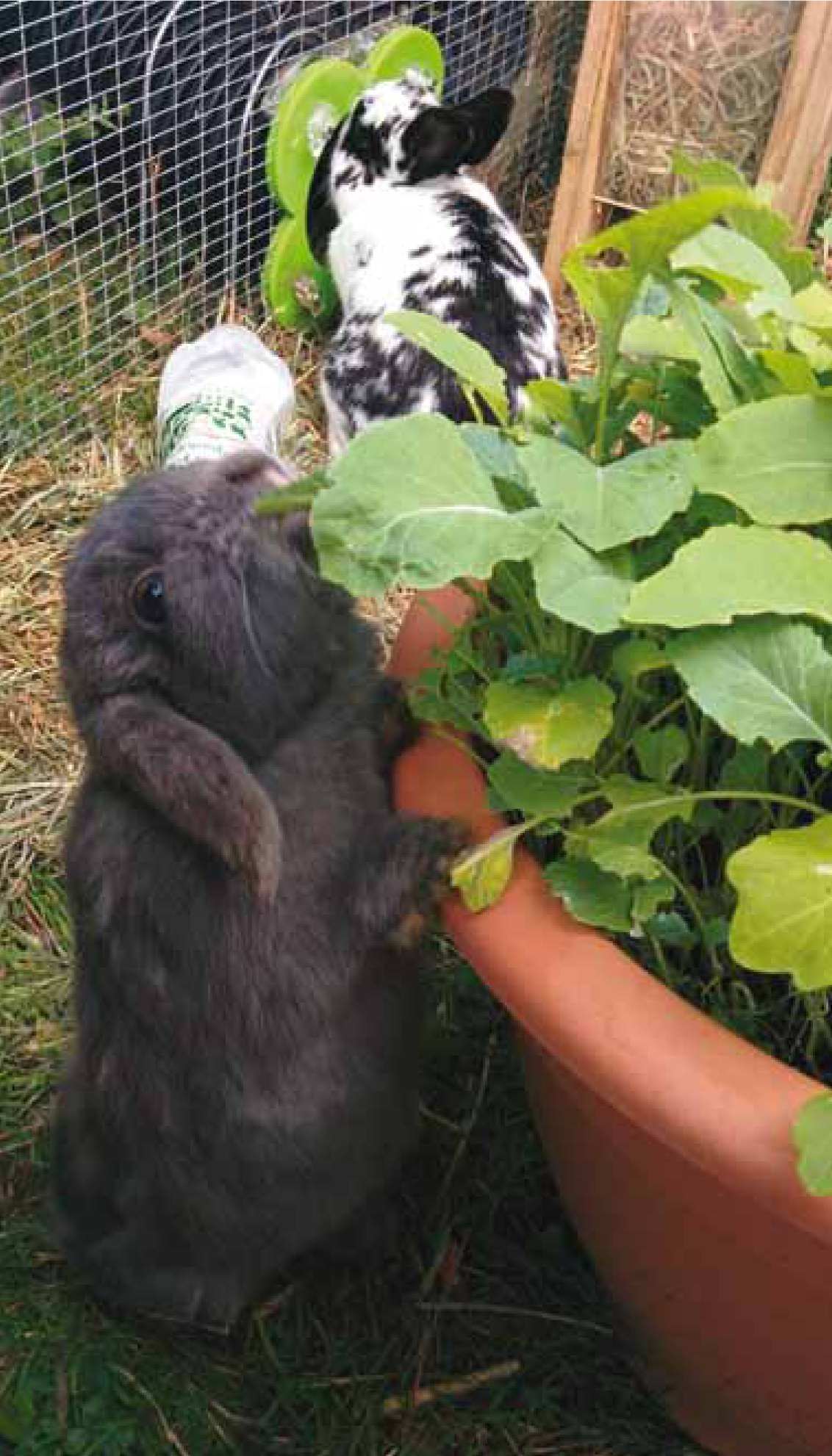
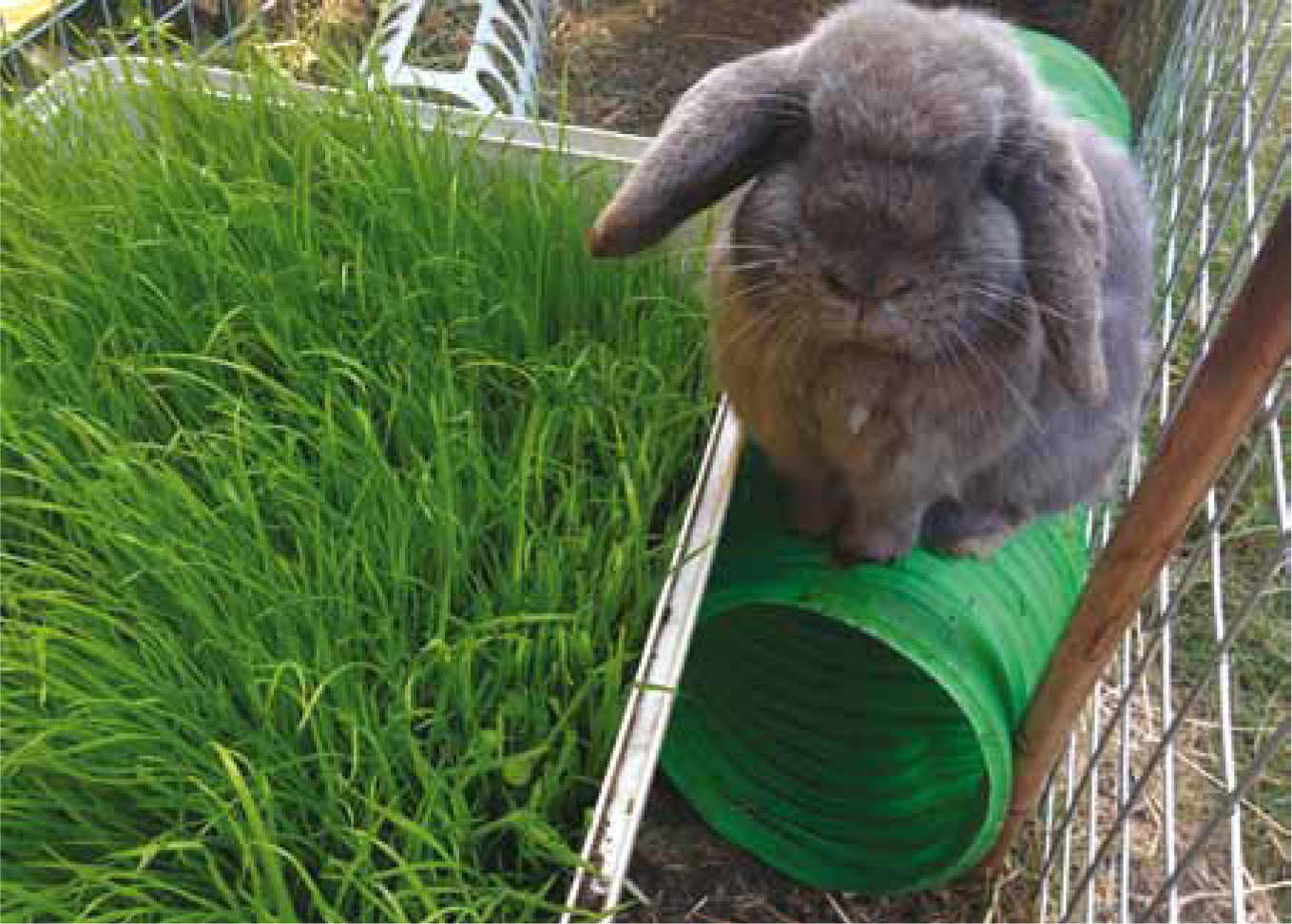
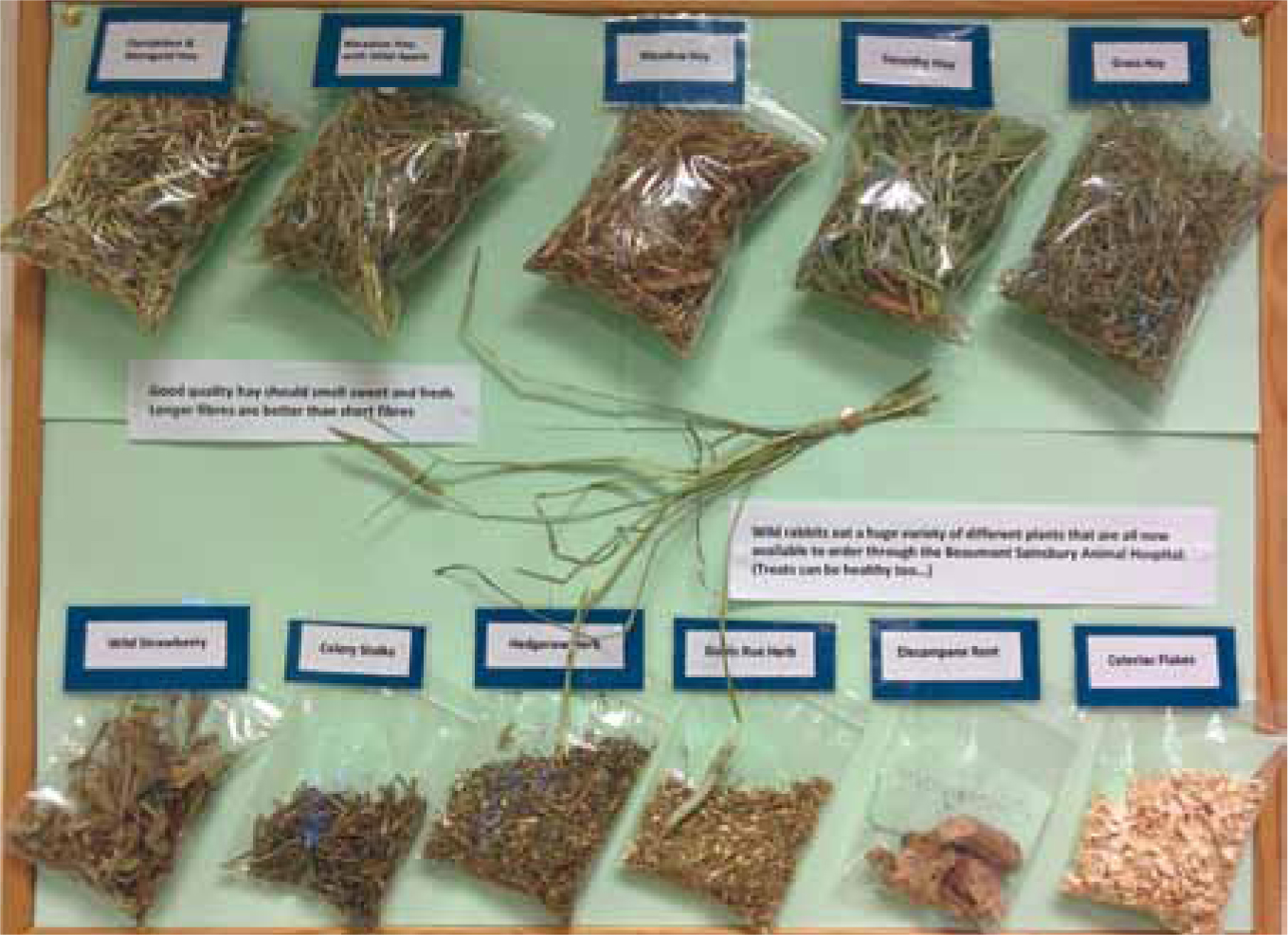
Hide salad greens and vegetables inside empty egg cartons, toilet paper rolls, boxes or even empty yogurt pots (Figure 7). It is even possible to make use of some of the foraging toys available for birds, dogs and cats (Figure 8), but it is not necessary to spend a lot of money. Environmental enrichment can be done simply and cheaply.
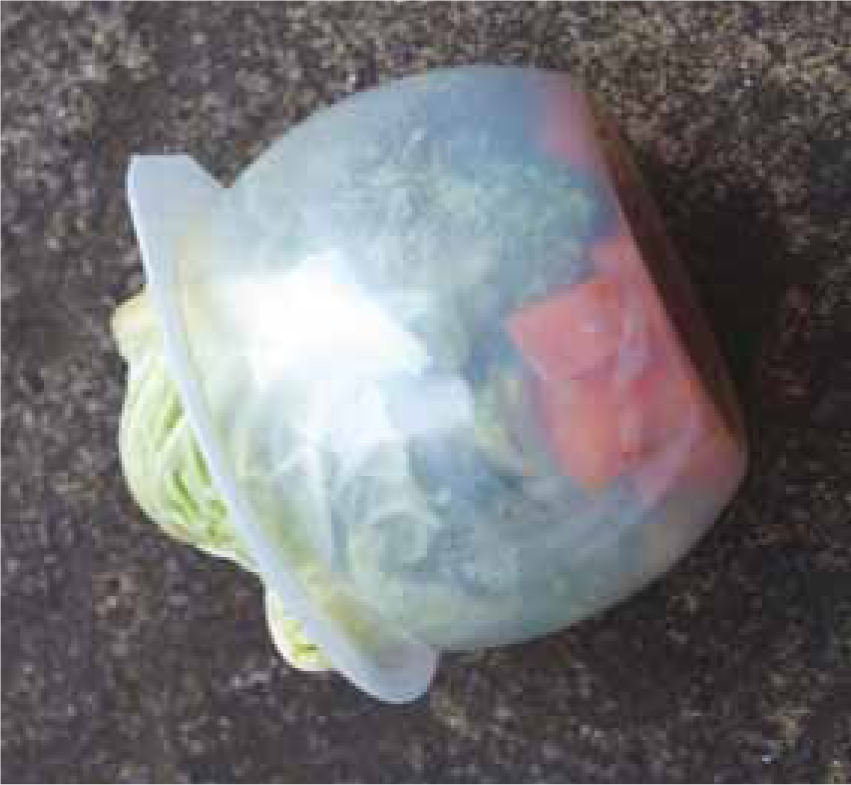
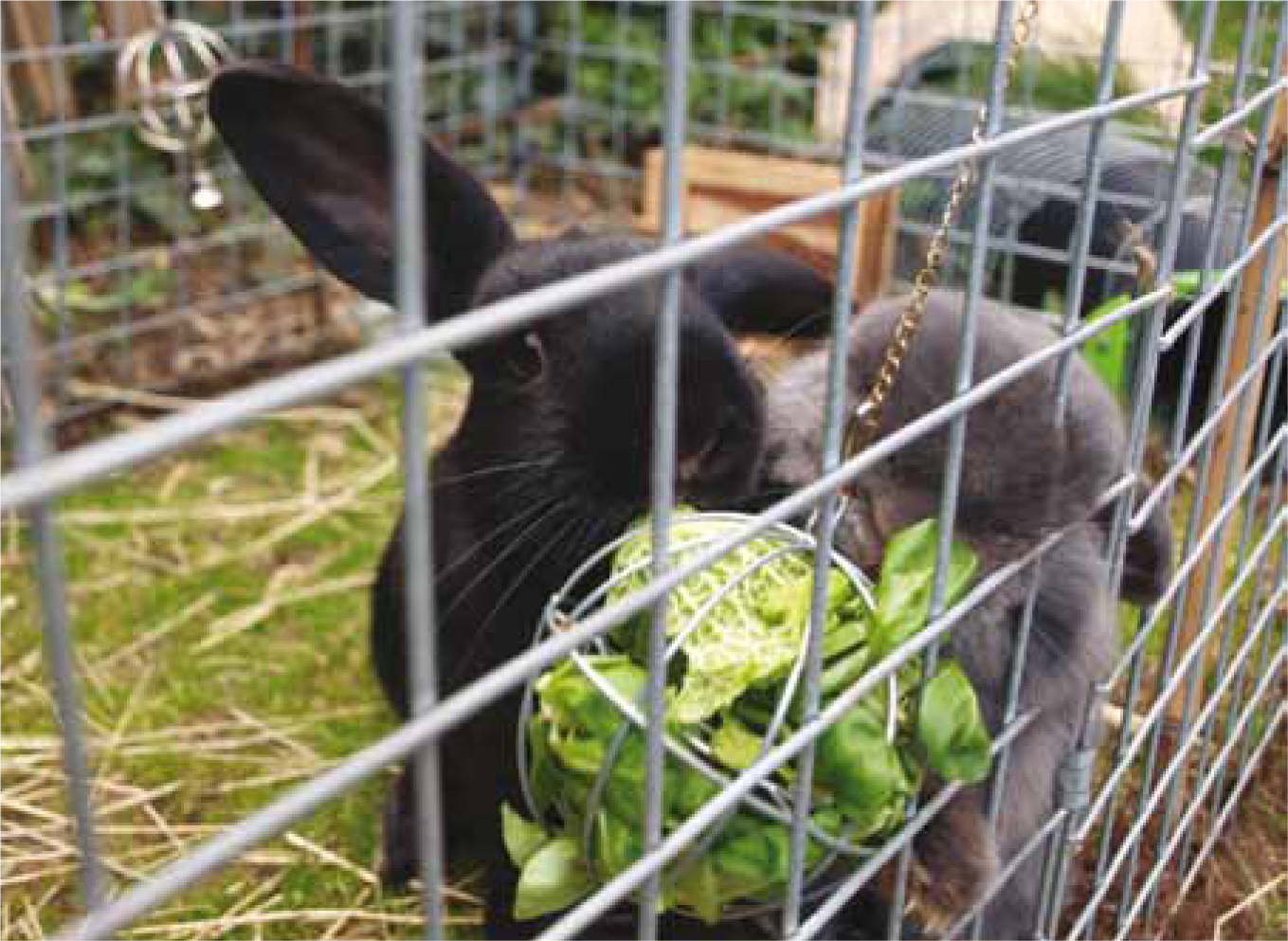
Companions
In a study seeking to determine which was most important to a rabbit — food, shelter or companionship — social contact with another rabbit was ranked as important as food (Seaman et al, 2008). Singly housed laboratory rabbits were significantly more likely to perform destructive behaviours such as chewing the floor and bars and digging than those housed in pairs (Chu et al, 2004).
The goal of environmental enrichment is not just to stimulate natural behaviour but to reduce or avoid the animal exhibiting abnormal behaviours when in captivity (Poggiagliolmi et al, 2011). The author has had several cases of lone house rabbits who engaged in abnormal activities such as over grooming and biting the bars of their cage which stopped when they were bonded to a companion, and were given more freedom.
Rabbits are a complex combination of social and territorial. Owners of single rabbits should be encouraged to get their rabbit a friend, but to increase the likelihood of success they will need help to bond the rabbits. Simply bringing home a new rabbit and putting them both together could result in fighting and serious injury. The author recommends the services of a ‘bunny bonder’ to owners to improve the likelihood of success. People with experience at bonding rabbits together are usually contactable through rescue centres such as the RSPCA ((http://www.rspca.org.uk/home) or The Rabbit Welfare Association and Fund (http://www.rabbitwelfare.co.uk/). Not only are they likely to be more successful at helping to bond rabbits than owners, it encourages owners to rescue a rabbit which is a great option for finding a friend for their pet.
Promoting environmental enrichment
Owners can be reluctant to provide environmental enrichment due to financial constraints or constraints on time (Newberry, 1995). However, in the author's experience one of the biggest obstacles to providing a better environment for pets is lack of knowledge. Many owners are simply not even aware of environmental enrichment as a concept — particularly for species other than dogs and cats.
An article by Edgar and Mullan (2011) showed that the majority of owners questioned at the point of sale of their new rabbit intended to take it to the veterinary practice for an initial health check. If this could be encouraged throughout the veterinary profession through the development of relationships with pet stores and breeders and advertising new pet health checks through clinics, this could be an important opportunity to educate owners. The same study showed a disturbing lack of knowledge about correct diets and provision of the correct housing and companionship for rabbits so there is a great opportunity to improve animal welfare through educating the public in this area.
The hospitalised rabbit
In addition to the role of veterinary professionals as educators, veterinary practices can lead by example. All forms of enrichment can be adapted for the hospitalised patient. Environmental enrichment has been shown to reduce stress associated with travel and housing (Buijs et al, 2011b) and can be an important aspect of stress reduction in hospitalised rabbits:
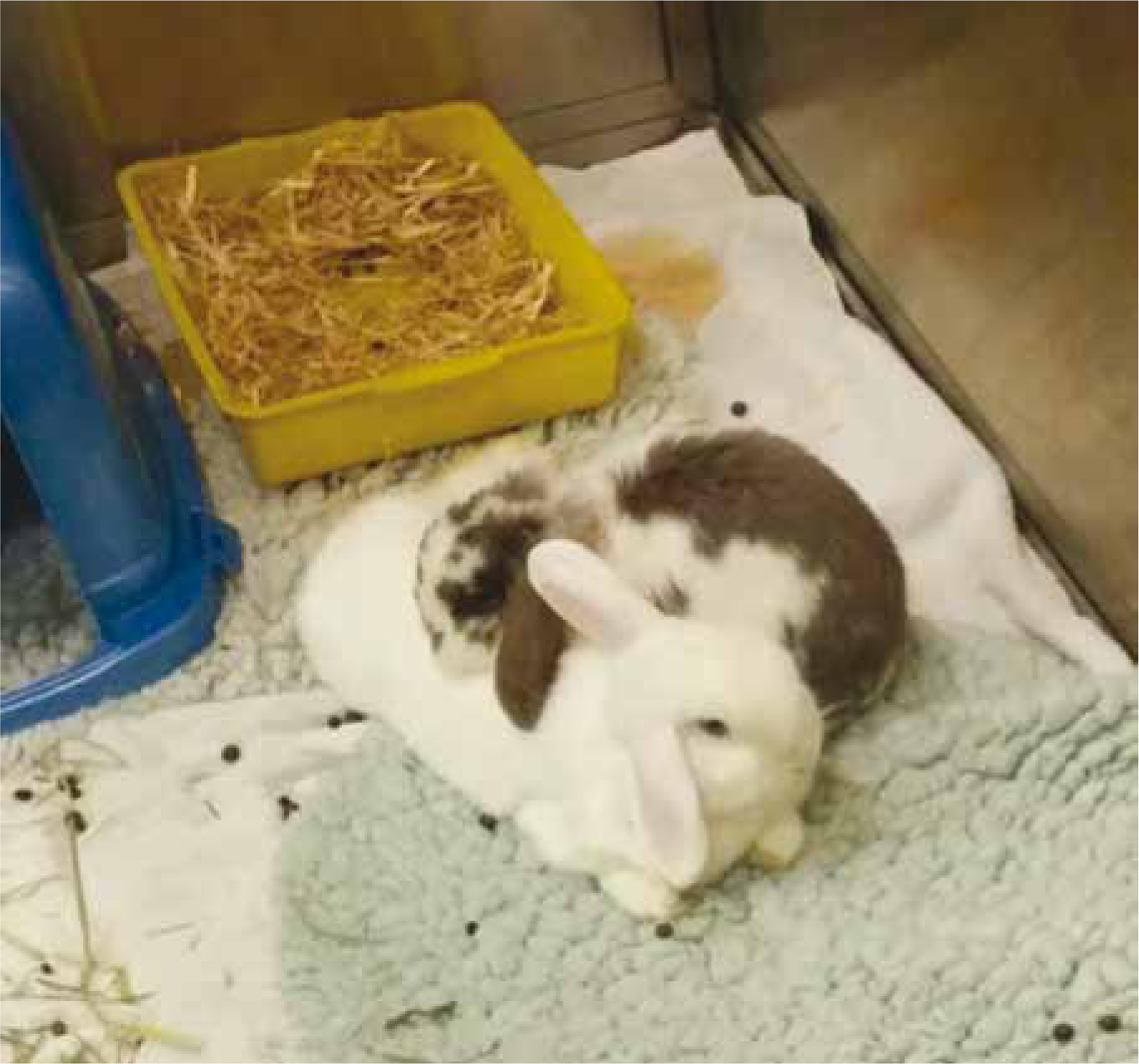
Conclusion
Owners' expectations of rabbit care have evolved and the veterinary profession should be moving with (if not staying ahead of) these expectations. Gratifyingly the UK is seeing a move away from people getting rabbits as ‘easy children's pets’ to a healthier (for both owner and rabbit) relationship between rabbit and owner which incorporates and seeks to enhance respect for rabbits as complex animals which have individual needs.
Many and varied studies have shown the benefits of increasing space, providing opportunities to forage, explore and have companionship in both laboratory rabbits and rabbits for consumption, it seems sad that the pet rabbit keeping population in many ways lags behind this trend. Breeders, pet store employees and veterinary staff should engage more with the rabbit owning public to improve their knowledge of rabbit husbandry. Veterinary professionals may have no control over what pet owners are told by other parties but they can control and improve the information they provide. The onus is on the veterinary professional to be knowledgeable on the subject of rabbit care and disseminate the most up to date care and husbandry advice. As writer Antoine de Saint-Exupery once penned: ‘You remain responsible, forever, for what you have tamed’.

